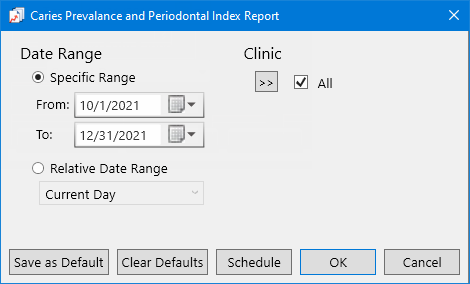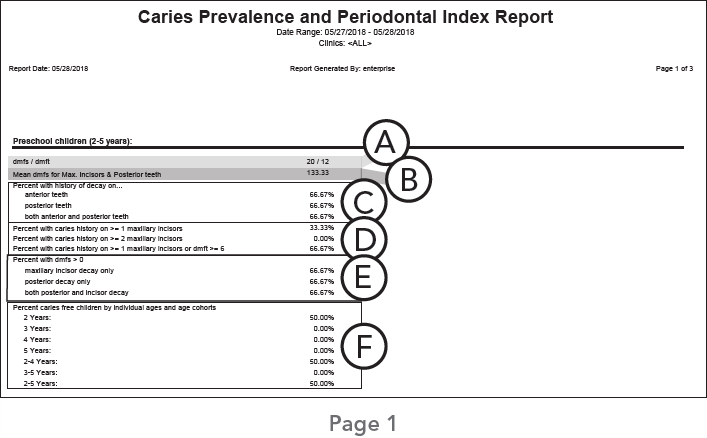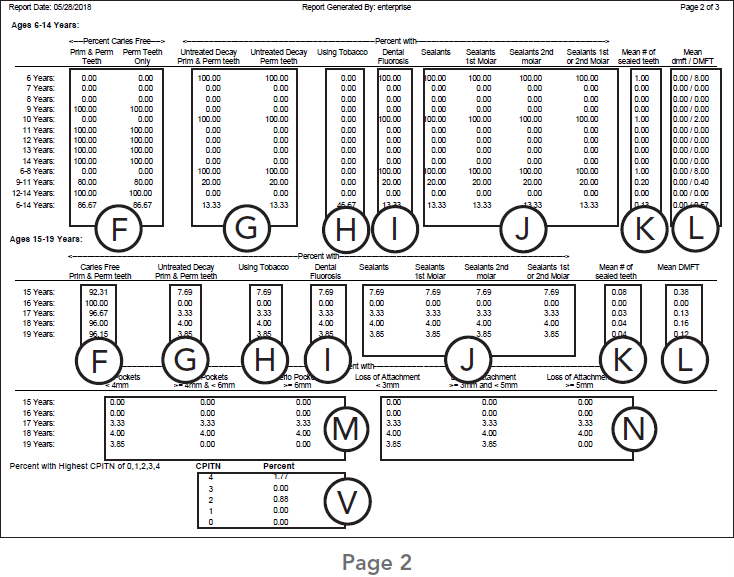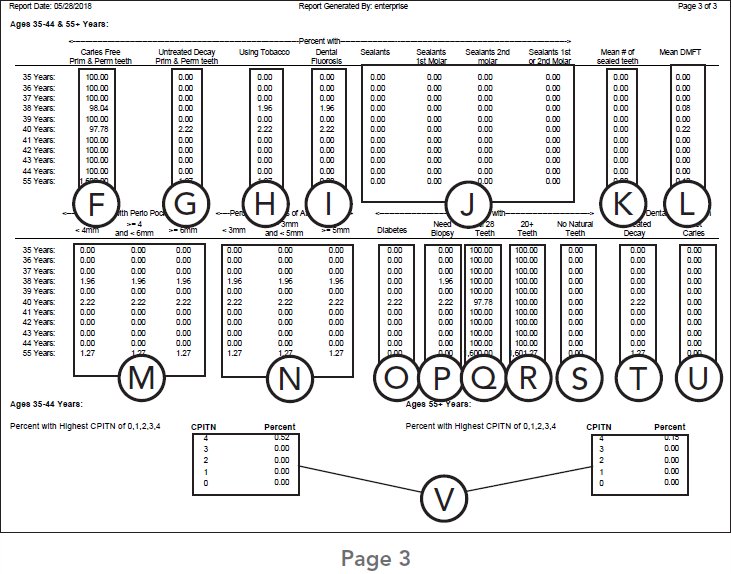The Caries Prevalence and Periodontal Index Report indicates, for various age ranges, how many patients have caries and how many do not, the number of patients with certain conditions, and patients' perio measurements (for example, pocket depths and loss of attachment).
|
|
Why: |
To print a record of patient statistics for caries, conditions, and perio measurements |
|
When: |
Quarterly |
To generate the report
In DXOne Reporting, select Lists, and then double-click Caries Prevalence and Periodontal Index Report.
The Caries Prevalence and Periodontal Index Report dialog box appears.

Set up the following options:
Date Range - To filter the report by date, do one of the following:
To include clinical notes that have dates within a range that you specify, select the Specific Range option. With this option selected, do one of the following:
Enter a date range (in a m/d/yyyy format) in the From and To boxes.
To select a date, do the following for From and To:
Click the corresponding calendar icon to view a month calendar.

Navigate to the correct month, using the left and right arrows.
Note: To quickly change the year and month, click the month-year at the top of the calendar, navigate to the correct year, using the left and right arrows, and then click the correct month.
Click the correct day.
To include clinical notes that have dates within a range that is relative to the report date, select the Relative Date Range option. With this option selected, select one of the following relative date ranges from the list:
|
Current Day Current MTD Current Fiscal YTD Current Calendar YTD |
Previous Day Previous Week Previous Month Previous 3 Months Previous 6 Months Previous Fiscal Year Previous Calendar Year |
Next Day Next Week Next Month Next 3 Months Next 6 Months Next Fiscal Year Next Calendar Year |
Notes:
Using a relative date range is recommended if you want to save the current report settings as the default settings so you do not have to manually enter a date range each time you run the report.
For a patient to be included on the report, he or she must have a visit with a date within the specific date range or relative date range.
Clinic - To filter the report by the clinics that are associated with procedures, conditions and perio exams, do one of the following:
To include all clinics that you are allowed to generate the report for, select the All checkbox.
To include specific clinics, do the following:
Click the search button  .
.
The Select Clinics dialog box appears.

Note: Only the clinics that you are allowed to generate the report for are available.
If the list is long, to search for a clinic by ID and/or title, do the following:
Click Search.
The options for searching appear in the upper list.

Enter the first character or more of a clinic's ID and/or title in the ID and Practice Title boxes, respectively.
Click Show Results to view a list of matching clinics.
Note: To return to viewing the list of all the clinics, click Search, click Clear Search to clear the search criteria that you entered, and then click Show Results.
In the upper list, select one or more clinics.
Note: To select multiple clinics, click a clinic, and then, while pressing the Ctrl key, click the other desired clinics. To select a range of adjacent clinics, click the first clinic of the desired range of clinics, and then, while pressing the Shift key, click the last clinic of the desired range of clinics.
Click Add.
Repeat steps b-d as needed to add other clinics.
Note: To not include a clinic that you added, select that clinic in the lower list, and then click Remove.
Click OK.
Click Save as Default to save the current settings for the next time you run the report.
Click Clear Defaults to revert the dialog box options to the original defaults.
Click Schedule to schedule a report job.
Click OK to preview the report.
Important information this report provides
This report prints on three pages with statistics for five age groups:
The age group 2 - 5 years is on the first page.
The age groups 6 - 14 years and 15 - 19 years are on the second page.
The age groups 35 - 44 years and 55 years and older are on the third page.
You need to be familiar with the following terms before reading this report:
Caries Free - No decayed, missing, or filled teeth
CPITN - Community Periodontal Index of Treatment Needs
Dmfs - Decayed, missing, or filled surfaces on primary teeth
DMFS - Decayed, missing, or filled surfaces on permanent teeth
Dmft - Decayed, missing, or filled primary teeth
DMFT - Decayed, missing, or filled permanent teeth
Dentate - Having teeth (a patient who does not have a full set of dentures)
Fluorosis - An abnormal condition of the tooth enamel caused by excessive exposure to fluoride

The data for each of the following statistics is listed by individual ages and age ranges:
dmfs / dmft:
dmfs - The total number of surfaces with one or more untreated caries for all patients in the age group, total number of surfaces with one or more fillings, and total number of teeth (multiplied by 5 surfaces) that have been extracted (using the oral surgery procedures D7111, D7140, D7210, D7220, D7230, D7240, D7241, D7250). A surface with a code posted for untreated followed by a code posted for restoration or extraction only counts once.
dmft - The total number of teeth with one or more untreated caries for all patients in the age group, the total number of teeth with one or more fillings, and the total number of teeth that have been extracted (using the oral surgery procedures D7111, D7140, D7210, D7220, D7230, D7240, D7241, D7250) or are missing. A tooth with a code posted for untreated followed by a code posted for restoration or extraction only counts once.
Mean dmfs - The mean dmfs for maxillary incisors and posterior teeth, which is the dmfs of maxillary incisors (c-h) and posterior teeth (a, b, i, j, k, l, s, and t) for all patients in the age group divided by the number of patients in the age group. A surface with an untreated caries code that has been fixed later is counted only once.
Decay History - The percent of patients in the age group with a history of decay. The statistics are broken down by decay on anterior teeth, posterior teeth, and both. Each value is the total number of patients in the age group with a caries code (15104, 15105, 15106, or 15107) or restorative code on any anterior, posterior, or anterior and posterior teeth divided by the number of patients in the age group.
Caries History - The percent of patients in the age group with caries history. The statistics are broken down by one or more caries on any maxillary incisor, two or more caries on any maxillary incisor, and one or more caries on any maxillary incisors or where dmft is greater than or equal to 6. Each value is the total number of patients in the age group with a caries code (15104, 15105, 15106, or 15107) or restorative code on the given number of caries on any of the maxillary incisors (or the total number of patients in the age group with a dmft greater than or equal to 6) divided by the number of patients in the age group.
dmfs > 0 - The percent of patients in the age group with a dmfs that is greater than 0.
Caries Free - The percent of patients of each given age (or in each given age range) without caries. To be considered caries free, a patient cannot have any of the following conditions or codes posted in Chart:
Caries conditions - 15104, 15105, 15106, or 15107.
Missing teeth conditions - 15100 or 15101.
Procedure codes - D2000-D4276, D4910, D4999, D6000-D6079, D6100, D6199-D7259, or D7999.

The data for each of the following statistics is listed by individual ages and age ranges:
Caries Free - The percent of patients of each given age (or in each given age range) without caries. This statistic is broken down by primary and permanent teeth and permanent teeth only. To be considered caries free, a patient cannot have any of the following conditions or codes posted in Chart:
Caries conditions - 15104, 15105, 15106, or 15107.
Missing teeth conditions - 15100 or 15101.
Procedure codes - D2000-D4276, D4910, D4999, D6000 - D6079, D6100, D6199 - D7259, or D7999.
Untreated Decay - The percent of patients of each given age (or in each given age range) with untreated decay. An untreated caries is any caries condition code (15104, 15105, 15106, or 15107) that has not had either a procedure that covers the same surface posted after the caries condition code was posted or has not had the corresponding tooth extracted (an existing, existing other, or missing tooth condition is considered extracted for the purposes of this report). This statistic is broken down by primary and permanent teeth and permanent teeth only. A restoration code on a tooth followed chronologically by an untreated caries condition indicates that the tooth decayed again after it was fixed and is counted as untreated decay.
Using Tobacco - The percent of patients of each given age or in each given age range (with caries) who are using tobacco (patients who have the condition code "15203 Tobacco Use" posted in Chart).
Dental Fluorosis - The percent of patients of each given age or in each given age range (with caries) who have dental fluorosis (patients who have the condition code "15200 Dental Fluorosis" posted in Chart).
Sealants - The percent of patients of each given age or in each given age range (with caries) who have dental sealants (patients who have the sealant code D1351 posted in Chart).
Mean # of Sealed Teeth - The total number of sealed teeth for all patients of each given age (or in each given age range) divided by the number of patients of each given age (or in each given age range).
Mean dmft/DMFT - The dmft/DMFT for all patients of each given age (or in each given age range) divided by the number of patients of each given age (or in each given age range). A tooth with an untreated caries code that has been fixed later is counted only once.
The data for each of the following statistics is listed by individual ages:
Caries Free - The percent of patients of each given age without caries. This statistic applies to both primary and permanent teeth. To be considered caries free, a patient cannot have any of the following conditions or codes posted in the Chart:
Caries conditions - 15104, 15105, 15106, or 15107.
Missing teeth conditions - 15100 or 15101.
Procedure codes - D2000-D4276, D4910, D4999, D6000-D6079, D6100, D6199-D7259, or D7999.
Untreated Decay - The percent of patients of each given age with untreated decay. An untreated caries is any caries condition code (15104, 15105, 15106, or 15107) that has not had either a procedure that covers the same surface posted after the caries condition code was posted or has not had the corresponding tooth extracted (an existing, existing other, or missing tooth condition is considered extracted for the purposes of this report). This statistic applies to both primary and permanent teeth. A restoration code on a tooth followed chronologically by an untreated caries condition indicates that the tooth decayed again after it was fixed and is counted as untreated decay.
Using Tobacco - The percent of patients of each given age (with caries) who are using tobacco (patients who have the condition code "15203 Tobacco Use" posted in Chart).
Dental Fluorosis - The percent of patients of each given age (with caries) who have dental fluorosis (i.e. patients who have the condition code "15200 Dental Fluorosis" posted in Chart).
Sealants - The percent of patients of each given age (with caries) who have dental sealants (patients who have the sealant code D1351 posted in Chart).
Mean # of Sealed Teeth - The total number of sealed teeth for all patients of each given age divided by the number of patients of each given age.
Mean dmft/ DMFT - The dmft/ DMFT for all patients of each given age divided by the number of patients of each given age. A tooth with an untreated caries code that has been fixed later is counted only once.
Perio Pockets - The percent of patients of each given age with the specified perio pocket measurements.
Loss of Attachment - The percent of patients of each given age with the specified clinical attachment level.
CPITN - The percent of patients in both age groups combined (ages 6 - 19) with the highest CPITN of 0, 1, 2, 3, and 4. CIPTN is calculated from periodontal exams within the date range of the report:
Any patients who have a Probing Depth (PD or Pocket Depth) for any tooth higher than 6 mm are counted towards the 4 category and are not counted towards any other category.
Any patients who have a Probing Depth (PD or Pocket Depth) for any tooth of 4 - 6 mm are counted towards the 3 category and are not counted towards any other category.
Any patients that are marked as having Plaque (not set to "0 - None") and a Probing Depth (PD or Pocket Depth) for any tooth less than 4 for any tooth are counted towards the 2 category and are not counted towards any other category.
Any patients that have bleeding marked for any tooth are counted towards the 1 category and are not counted towards any other category.
Any remaining patients should be counted towards the 0 category.

The data for each of the following statistics is listed by individual ages:
Caries Free - The percent of patients of each given age without caries. To be considered caries free, a patient cannot have any of the following conditions or codes posted in Chart:
Caries conditions - 15104, 15105, 15106, or 15107.
Missing teeth conditions - 15100 or 15101.
Procedure codes - D2000-D4276, D4910, D4999, D6000-D6079, D6100, D6199-D7259, or D7999.
Untreated Decay - The percent of patients of each given age with untreated decay. An untreated caries is any caries condition code (15104, 15105, 15106, or 15107) that has not had either a procedure that covers the same surface posted after the caries condition code was posted or has not had the corresponding tooth extracted (an existing, existing other, or missing tooth condition is considered extracted for the purposes of this report). A restoration code on a tooth followed chronologically by an untreated caries condition indicates that the tooth decayed again after it was fixed and is counted as untreated decay.
Using Tobacco - The percent of patients of each given age (with caries) who are using tobacco (patients who have the condition code "15203 Tobacco Use" posted in Chart).
Dental Fluorosis - The percent of patients of each given age (with caries) who have dental fluorosis (patients who have the condition code "15200 Dental Fluorosis" posted in Chart).
Sealants - The percent of patients of each given age (with caries) who have dental sealants (patients who have the sealant code D1351 posted in Chart).
Mean # of Sealed Teeth - The total number of sealed teeth for all patients of each given age divided by the number of patients of each given age.
Mean DMFT - The DMFT for all patients of each given age divided by the number of patients of each given age. A tooth with an untreated caries code that has been fixed later is counted only once.
Perio Pockets - The percent of patients of each given age with the specified perio pocket measurements.
Loss of Attachment - The percent of patients of each given age with the specified clinical attachment level.
Diabetes - The percent of patients of each given age (with perio measurements that appear on this report) who have diabetes (patients who have the condition code "15201 Diabetes" posted in Chart).
Need Biopsy - The percent of patients of each given age (with perio measurements that appear on this report) who need biopsies (patients who have the condition code "15202 Needs Biopsy" posted in Chart).
All 28 Teeth - The percent of patients of each given age who have all 28 natural teeth (patients who do not have any Existing, Existing Other, or Completed extractions, other than wisdom teeth, or condition codes "15100 Missing Tooth > 1 year" or "15101 Missing Tooth" posted in Chart).
20+ Teeth - The percent of patients of each given age who have 20 or more natural teeth. A patient has a missing tooth if an extraction, appropriate condition, or appropriate Existing/Existing Other code is posted in Chart.
No Natural Teeth - The percent of patients of each given age who have no natural teeth.
Untreated Decay (Dentate Adults) - The percent of dentate patients of each given age with untreated decay (patients who do not have both D5110 and D5120 and have untreated decay-any condition code 15104-15107-posted in Chart). A restoration code on a tooth followed chronologically by an untreated caries condition indicates that the tooth decayed again after it was fixed and is counted as untreated decay.
Root Caries (Dentate Adults) - The percent of dentate patients of each given age with root caries (patients who have the condition code "15104 Deep Dentinal/Cemental Caries" posted in Chart).
CPITN - The percent of patients in each age group (ages 35-44, and 55 and older) with the highest CPITN of 0, 1, 2, 3, and 4. CIPTN is calculated from periodontal exams within the date range of the report:
Any patients who have a Probing Depth (PD or Pocket Depth) for any tooth higher than 6 mm are counted towards the 4 category and are not counted towards any other category.
Any patients who have a Probing Depth (PD or Pocket Depth) for any tooth of 4-6 mm are counted towards the 3 category and are not counted towards any other category.
Any patients that are marked as having Plaque (i.e. not set to "0 - None") and a Probing Depth (PD or Pocket Depth) for any tooth less than 4 for any tooth are counted towards the 2 category and are not counted towards any other category.
Any patients that have bleeding marked for any tooth are counted towards the 1 category and are not counted towards any other category.
Any remaining patients should be counted towards the 0 category.